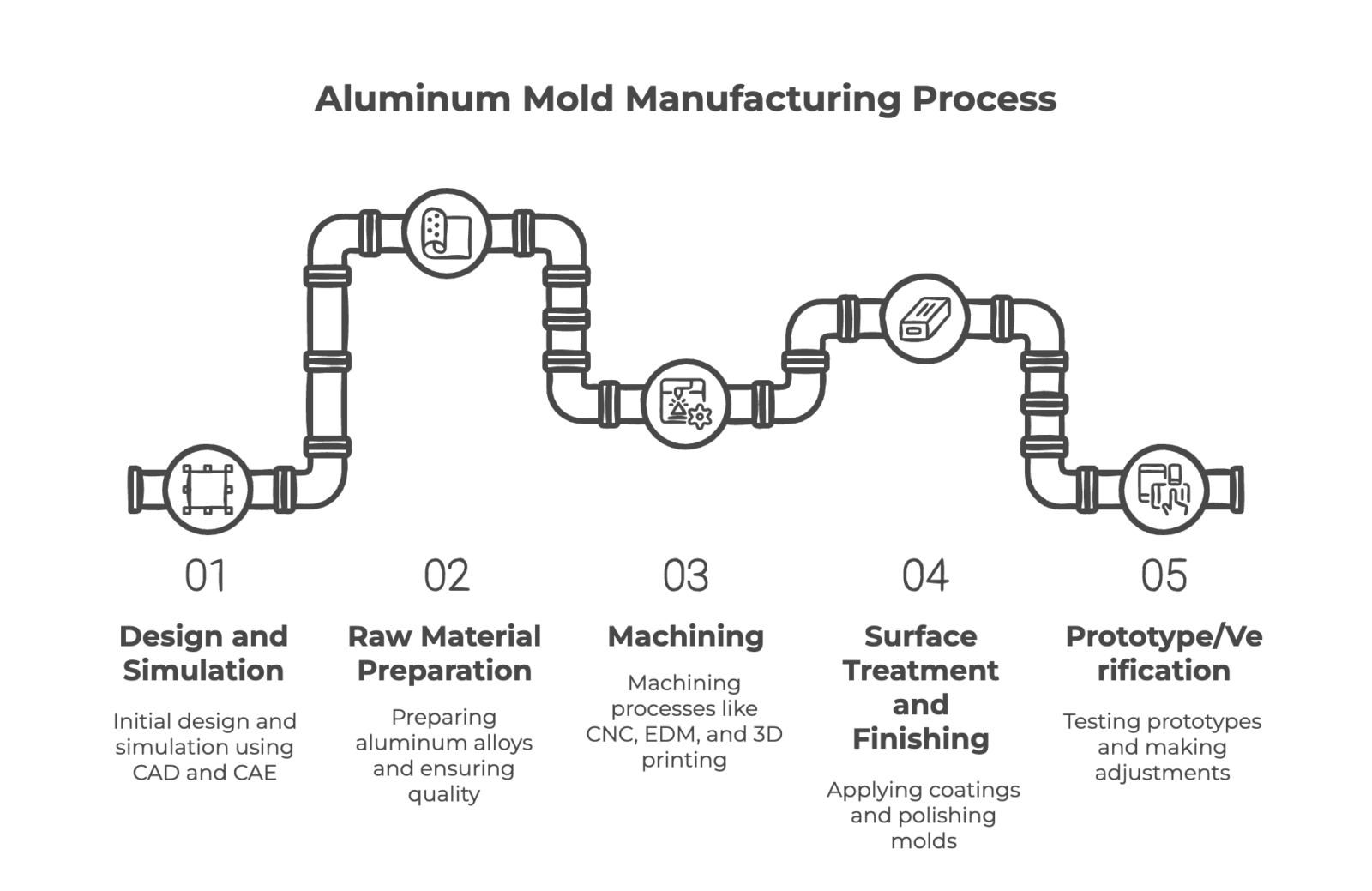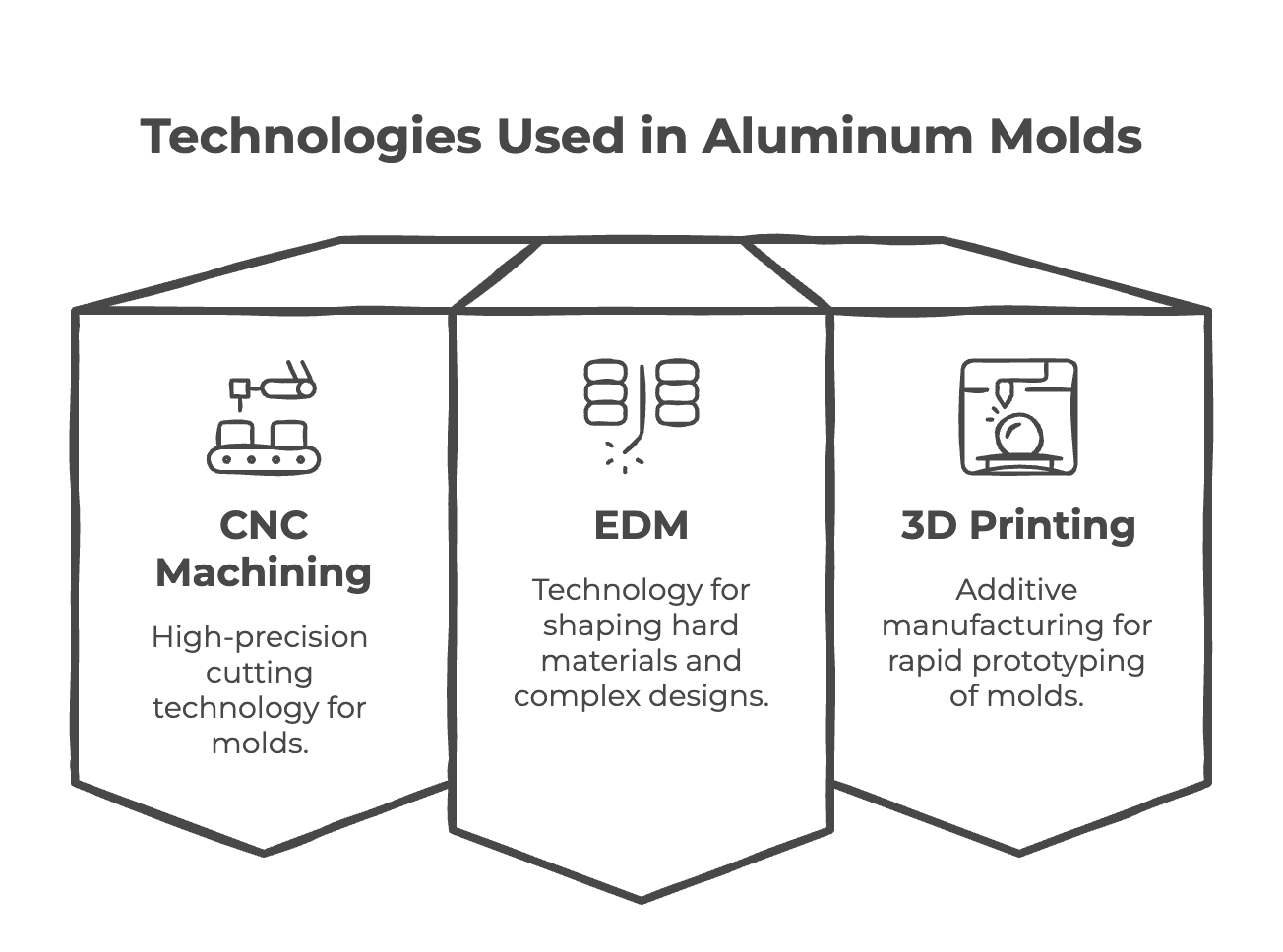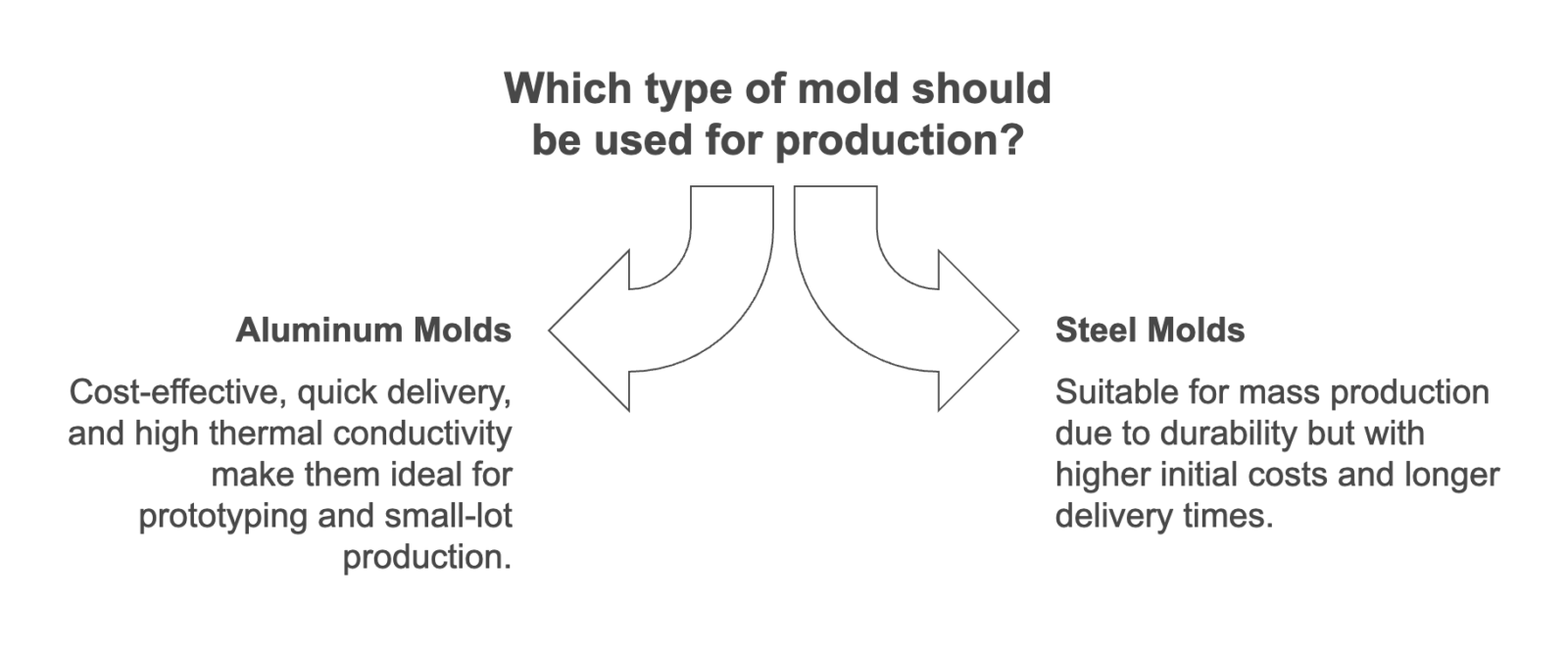◆Table of contents
ToggleIntroduction
Aluminum molds are molds made from aluminum alloys and are used in manufacturing processes such as injection molding and die casting. Compared to general steel molds, they are lightweight and easy to process, making them widely used for prototypes and small-lot production.
Aluminum molds are used in a wide range of fields, including automotive parts, electronic equipment, industrial machinery, and medical devices. They are particularly effective when short-term molding is required in the product prototyping stage or when manufacturing high-precision parts while keeping costs down.
Also, since aluminum has high thermal conductivity, it can shorten cooling time and speed up the molding cycle. This characteristic is an important factor that contributes to improved production efficiency and cost reduction.
Aluminum Mold Manufacturing Process
Design and Simulation
The manufacturing of aluminum molds begins with design and simulation. Detailed design is performed using CAD (Computer-Aided Design), considering the shape of the product and the usage environment. At this stage, it is important to optimize the accuracy, strength, and durability during molding.
Furthermore, after the design, simulation analysis using CAE (Computer-Aided Engineering) technology is performed to verify the durability and cooling efficiency of the mold, the risk of deformation during molding, etc. in advance. This can reduce the effort of prototyping and optimize costs and time.
Raw Material Preparation
Various aluminum alloys are used for aluminum molds depending on the application. For example, A7075 has high strength and wear resistance and is suitable for molds for precision parts. On the other hand, A5052 has excellent corrosion resistance and is also used for large molds.
At the time of raw material procurement, management of impurities and quality inspection are indispensable. By checking the component ratio and internal defects of the aluminum alloy, it is possible to prevent the occurrence of defects in the subsequent processes.
Machining
Various machining technologies are used for forming aluminum molds, such as:
- CNC Machining
- High-precision cutting by CNC (Computer Numerical Control) is one of the basic manufacturing methods for aluminum molds. Precision machining in micron units is possible by program, and molds with complex shapes can be manufactured consistently.
- Electrical Discharge Machining (EDM)
- EDM (Electrical Discharge Machining) is a technique that uses electrodes to process aluminum while gradually melting it. It is particularly suitable for micro-machining and manufacturing sharp-angled shapes, and can realize shapes that are difficult with CNC machining.
- 3D Printing
- In recent years, with the evolution of metal 3D printing technology, it has come to be used for the manufacture of prototype molds. It is possible to reproduce internal structures that are difficult with conventional cutting, and rapid verification can be performed at the prototype stage.
Surface Treatment and Finishing
Surface treatment is applied to improve the durability of aluminum molds and the quality of molded products.
- Coating Technology
- TiN (titanium nitride) coating and DLC (diamond-like carbon) coating may be applied to improve wear resistance and heat resistance. This can suppress wear during molding and extend the life of the mold.
- Polishing/Assembly
- In the final process, finishing by manual or automatic polishing machines is performed. This removes fine irregularities on the mold surface and improves the molding quality of the product. Each part of the mold is assembled, and final adjustments are made.
Prototype/Verification
The completed mold is tested using a prototype mold to verify that the product can be molded as designed. If deformation or dimensional error occurs during molding, fine adjustment of the mold is required.
After making corrections based on the prototype results and finishing to the optimum condition, the process moves to full-scale mass production. Careful adjustment at this stage greatly affects the quality and production efficiency of the final product.
Technologies Used in Aluminum Molds
CNC Machining
CNC (Computer Numerical Control) machining is a technology that performs high-precision cutting by computer control and is widely used in the manufacture of aluminum molds.
- High-Precision Cutting Using Rotating Tools
- In CNC machining, aluminum material is shaped while cutting using high-speed rotating tools (drills and end mills). Since high machining accuracy (micron units) is required, it is important to optimize cutting conditions and select tools.
- Precision Cavity Formation
- When forming the cavity (the recessed part of the mold), which is the main part of the mold, a smooth finish can be achieved by CNC machining. Also, machining time can be shortened and costs can be reduced by optimizing tool paths.
EDM (Electrical Discharge Machining)
EDM (Electrical Discharge Machining) is a machining technology that melts and removes metal by generating spark discharges between an electrode and a workpiece.
- Shaping Hard-to-Machine Materials and Complex Shapes
- Electrical discharge machining is suitable for machining hard materials and complex shapes that are difficult to cut using ordinary cutting. For example, it is effective when forming sharp-angled parts and fine grooves, and can realize detailed shapes that are difficult to reproduce with CNC machining.
- Method Suitable for Micro-Machining
- Using wire cut electrical discharge machining (Wire EDM), extremely small parts and precise contour machining are possible. Therefore, it is an indispensable technology for manufacturing micro mold parts.
3D Printing
3D printing (additive manufacturing technology) has recently come to be used in the manufacture of aluminum molds.
- Used for Rapid Prototyping
- By using 3D printing, prototype molds can be manufactured in a shorter time compared to conventional cutting and casting. This enables rapid evaluation and design changes at the prototype stage.
- Cost Reduction and Improved Design Freedom
- Using metal 3D printing technology, internal structures and lightweight designs that are difficult with conventional machining methods can be realized. Furthermore, it leads to cost reduction by reducing material waste.
By appropriately combining these technologies, the high precision and high efficiency of aluminum molds are advanced, contributing to the improvement of productivity in the manufacturing site.
Aluminum Mold Costs
Factors Determining Costs
The cost of aluminum molds varies depending on various factors. The main factors include:
- Mold Size and Complexity
- Larger molds and molds with complex shapes increase costs due to increased processing time and materials used. Especially when precise cavity shapes and fine details are required, additional processing steps occur, increasing the price.
- Required Accuracy
- Higher precision molds increase the time for CNC machining and electrical discharge machining, and require more finishing steps, resulting in higher costs. Especially precision molds with tolerances of ±0.01mm or less increase costs with increasing processing time.
- Production Volume (Small Lot vs. Mass Production)
- Molds for small-lot production often choose simple structures and low-cost machining methods to reduce initial investment, but molds for mass production need to increase durability, so more expensive manufacturing processes are used.
Mold Materials and Costs
Aluminum molds have several cost advantages compared to steel molds.
| Material | Cost | Durability | Machining Time | Characteristics |
|---|---|---|---|---|
| Aluminum | Low to Medium | Medium (tens of thousands of shots) | Short | Lightweight and easy to process, short cooling time |
| Steel (P20, H13, etc.) | High | High (hundreds of thousands of shots) | Long | High durability, suitable for mass production |
- Cost Comparison of Aluminum vs. Steel
- In general, aluminum is cheaper than steel, and the machining time is shortened, so there is an advantage that initial costs can be reduced.
- Long-Term Cost Benefits
- Steel is suitable for mass production because of its long life, but aluminum molds are suitable for short-term prototyping and small to medium-scale production. Because manufacturing costs and lead times can be reduced, there may be sufficient cost benefits from a long-term perspective.
Mold Life and Cost Efficiency
- Aluminum Mold Life and Durability
- The life of aluminum molds is usually around tens of thousands of shots, which is shorter than steel molds (hundreds of thousands of shots), but they are lightweight and easy to process, making them easy to repair and replace.
- Comparison of Cost Performance
- Considering the low initial cost and ease of processing, there are many cases where recovery is possible in a short period, and cost efficiency is high especially for prototyping and short-term production.
Specific Cost Examples
Mold prices vary depending on design and specifications, but here are examples of general price ranges.
| Mold Type | Estimated Price (USD) | Application |
|---|---|---|
| 1 Cavity Mold | 500-5000 | Small-scale production, prototyping |
| 2 Cavity Mold | 20000- | For medium to mass production |
| Mass Production Mold | 50000+ | High durability and high precision mass production |
- 1 Cavity Mold Price
- Simple molds with a single cavity are suitable for prototyping and small-scale production, and the price is relatively low, around 500-5000 dollars.
- 2 Cavity Mold Price
- Molds with two cavities are used to improve production efficiency and are designed for mass production. The price is generally 20,000 dollars or more.
- Cost Comparison for Mass Production and Small Lot Production
- In small-lot production, it is difficult to recover the initial cost of the mold, so low-cost aluminum molds are often chosen, but in mass production, high-durability steel molds may have long-term cost benefits.
Thus, the cost of aluminum molds is determined by various factors, so selection according to application and production volume is important.
Advantages of Aluminum Molds
High Cost Efficiency
Aluminum molds have a significant advantage in that they have lower initial costs than steel molds. Aluminum is easier to process than steel, and the time for cutting and electrical discharge machining can be shortened, which reduces mold manufacturing costs.
- Steel Mold Cost Comparison
- Steel molds are durable and suitable for mass production, but have high initial costs
- Aluminum molds can be manufactured at low cost and can be recovered in a short period
Especially for prototyping and small-lot production applications, using aluminum molds leads to cost reduction.
High Thermal Conductivity
Aluminum has about 3-5 times higher thermal conductivity than steel, so the mold is heated and cooled uniformly, which can be expected to shorten the molding cycle and improve product accuracy.
- Uniform cooling suppresses warpage and deformation of molded products
- Shortening the molding cycle improves production efficiency
- Contributes to energy cost reduction
The advantage is that the high thermal conductivity allows optimization of temperature control during molding of plastic and resin products.
Short Delivery Time
Aluminum molds can be manufactured in a shorter period compared to steel molds by utilizing CNC machining and 3D printing.
- CNC Machining Speed: Aluminum has higher machinability than steel, shortening machining time
- Use of 3D Printing: Prototype molds can be manufactured quickly
In general, steel molds can take several weeks to several months to deliver, but aluminum molds can be manufactured in a few days to a few weeks, making them suitable for prototype development that requires short delivery times.
Thus, aluminum molds have excellent characteristics in terms of cost, thermal conductivity, and delivery time, and optimal selection according to the application is important.
Cost Reduction Points
Extending Mold Life
Since aluminum molds are less durable than steel molds, it is important to devise ways to extend their lifespan. By adopting appropriate maintenance and processing methods, replacement frequency can be reduced and total costs can be reduced.
Optimizing Curing Time
If the curing time during molding is too long, mold wear tends to accelerate, so it is necessary to set an appropriate time. In the case of resin molding, it is important to optimize the cooling process and adjust it so as not to put unnecessary strain on the mold.
Utilizing Polishing and Surface Treatments
- Improve wear resistance with surface hardening treatments (anodizing, coating)
- Maintain the surface condition of the mold with regular polishing and maintenance
Especially by applying anodizing, it is possible to improve the wear resistance of aluminum molds and extend their lifespan.
Design Optimization
By considering cost reduction at the mold design stage, unnecessary processing can be reduced and manufacturing costs can be suppressed.
Reducing Mold Complexity
- Reduce manufacturing time and costs by reducing unnecessary processing
- Design with simple shapes to lower the difficulty of processing
For example, reducing sharp edges and fine irregularities can reduce the number of CNC machining steps and suppress the wear of cutting tools, which ultimately leads to cost reduction.
Reducing the Number of Parts
- Suppress assembly costs by reducing the number of parts and utilizing integral molding
- Reduce manufacturing costs by designing to mold multiple parts with one mold
Especially in resin molding, multi-cavity molds (molds that mold multiple products at the same time) can be used to improve production efficiency and reduce costs.
Material Selection According to Production Volume
By selecting appropriate materials according to production volume, the balance between cost and durability can be optimized.
High Durability Materials for Mass Production
- Improve wear resistance by adopting hard aluminum alloys (e.g., 7075 aluminum)
- Reduce the frequency of mold replacement by applying high-strength surface treatments
In mass production, extending mold life is the top priority, so it is reasonable to choose highly durable materials even if the initial cost is high.
Cost Reduction Measures for Prototyping and Small-Lot Production
- Suppress manufacturing costs by using low-cost aluminum alloys (e.g., 6061 aluminum)
- Reduce mold manufacturing time and costs by utilizing 3D printing
In prototyping and small-lot production, rapid manufacturing and low cost are more important than durability, so significant cost reductions can be achieved by selecting appropriate materials and manufacturing processes.
Summary
Aluminum molds are used in various industries because of their lightweight properties, high thermal conductivity, and ease of processing. Especially in fields such as automotive parts, electronic equipment, and industrial machinery, the benefits of short delivery times and cost reduction can be enjoyed, making them attracting attention as an alternative to steel molds.
To reduce costs, appropriate material selection, design optimization, and utilization of surface treatments are important. By ensuring durability while suppressing mold complexity, long-term cost performance can be improved. Also, the use of CNC machining and 3D printing can improve the efficiency of the manufacturing process.
In the future, further cost reductions and performance improvements are expected due to the development of new aluminum alloys and the evolution of processing technology. Especially, the development of simulation technology using AI and the spread of higher precision processing technology will further expand the possibilities of aluminum molds.



